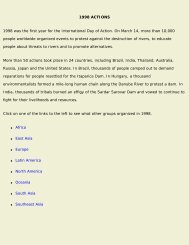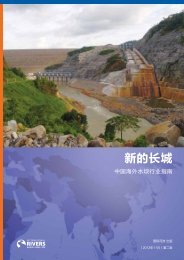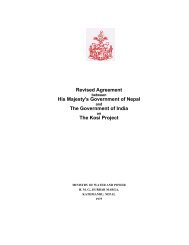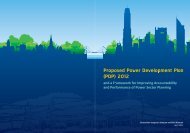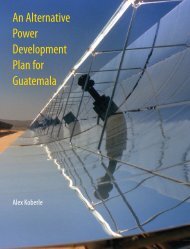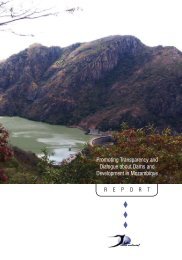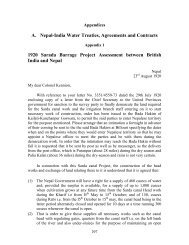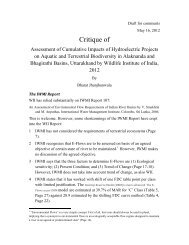Mountains of Concrete - International Rivers
Mountains of Concrete - International Rivers
Mountains of Concrete - International Rivers
You also want an ePaper? Increase the reach of your titles
YUMPU automatically turns print PDFs into web optimized ePapers that Google loves.
The Regional ParadoxThe Himalayan mountain ranges that stretch across a 2,400 km arc form an ecological system whose diverseelements are interlinked together in many complex ways. The highest Himalayan mountains influence the lives<strong>of</strong> people several thousand kilometres away on the plains. <strong>Rivers</strong> originating at one point in the region traverse acrosslong distances, unifying and connecting areas far apart. There is little doubt that this is a highly diverse yet cohesivelyinterlinked region.The most important links between the countries <strong>of</strong> thisregion are its rivers. Almost each and every one <strong>of</strong> the majorrivers is a trans-boundary one. The Indus River originates inTibet, travels through India and then into Pakistan, where itdescends from the mountains onto the plains to eventuallymeet the sea. The Satluj River, too, rises near Mansorovarin Tibet, and then, after traversing through India andPakistan, eventually meets the Chenab and the Indus rivers.The major rivers <strong>of</strong> Nepal, like the Mahakali and Karnali,originate in the Himalayas, run through Nepal and theninto India to meet the mighty Ganga. The Ganga Riveritself flows on to Bangladesh. The Tsangpo River originatesin Tibet, flows into Arunachal Pradesh in India as the Siang(Dihang) River, then into Assam as the Brahmaputra Riverafter receiving the waters <strong>of</strong> many other rivers, and finallyflows onto Bangladesh, where it is called the Jamuna River.Thus, the rivers <strong>of</strong> the region form vital links from the highmountains to the sea.Political boundaries cut sharply through the region,dividing it into areas that have many common geographical,topographical and eco-climatic features but starkly differentpolitical and economic contexts.While Nepal and Bhutan continue to be primaryproduction economies with low industrialization andlarge parts <strong>of</strong> the populations dependent on agriculture,Pakistan and India are much more industrialized. As a result,developmental policies, priorities and constraints also differin each <strong>of</strong> the four countries.Relations between the different countries are alsomixed. Nepali and Indian citizens can move freely betweenthe two countries without a visa. On the other hand, eventhough Pakistan and India were one country about 60 yearsago, the history and legacy <strong>of</strong> partition has led to strainedrelations between them. Notwithstanding this, India andPakistan negotiated and signed the Indus Water Treaty in1960 and have successfully implemented the sharing <strong>of</strong> theIndus Basin river waters since then.Whatever the relationships are at the <strong>of</strong>ficial levels, thepeople <strong>of</strong> India and Pakistan share deep social, cultural andfamilial ties as well as friendships. While similar relationshipsexist between the people <strong>of</strong> India and Nepal, andnotwithstanding the open borders, there is deep resentmentamongst many Nepali people with the rulers in NewDelhi that stems from the feeling that many <strong>of</strong> the bilateralwater-sharing agreements have favored India. Bangladesh isdownstream <strong>of</strong> all the Himalayan rivers <strong>of</strong> Nepal and India,but has little say in the dam building program that is plannedin these areas.Thus, the Himalayan region is a remarkable combination<strong>of</strong> an area with strong ecological, geographical, culturaland social links fractured by political divisions, hostilityand differing economic and political contexts. Thesecommonalities and differences, the links and the fissures,significantly influence the dam-building programs, theirfeatures and even the likely outcomes. We will examinesome <strong>of</strong> these important features where relevant.<strong>Mountains</strong> <strong>of</strong> <strong>Concrete</strong>: Dam Building in the Himalayas | 5




